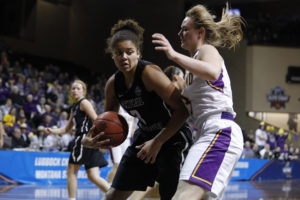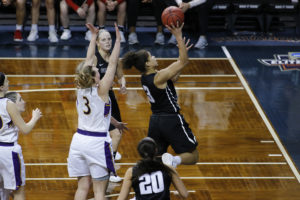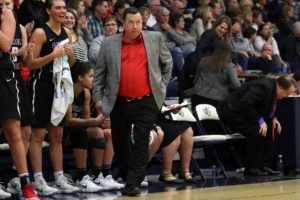How Central Missouri shocked the Goliath of DII women’s basketball
March 12, 2016, was the last time Ashland University had lost a game heading into this year’s NCAA Division II women’s national championship. Its 73 consecutive wins was the fourth-best streak of any division, and its 99 points per game was enough to make any defense cringe. But Central Missouri University and head coach Dave Slifer didn’t flinch.
The Jennies’ 66-52 victory over Ashland was one of 2018’s biggest upsets in college basketball. Sophomore Megan Skaggs said after the game it was the team’s “refuse to lose” attitude that carried players throughout the season, but it also required a defense that suffocated the nation’s top scoring offense.
Slifer spoke with Winning Hoops just 11 days after beating the team some referred to as “the UConn of Division II.” Here’s what he had to say about the national championship and his strategy.WH: How do you prepare to face a team with 73 straight wins?

Slifer: The bottom line is all year long we’ve been a possession-type team. We fast break, but if we don’t fast break, we’re going to run the clock down and make you play some defense. That kind of fit into what we were doing in that game.
Ashland was getting 30 percent of their shots off in the fast break, so we had to do whatever we could to stop them there. It started with our press offense; if we have a layup, we’ll take it, otherwise we’ll run some offense. We ended up having four shot-clock violations during the game, which is quite a few turnovers, but they can’t make fast-break layups when the whistle blows.
WH: You faced a lot of pressing teams and transition offenses during the tournament. How do you like to combat that?

Slifer: We love offensive rebounding, but we’re not the best offensive rebounding team because we’re a four-out motion team most of the time.
It’s a lot harder to get on the fast break when you’re grabbing offensive rebounds and putting it back in. We were pretty fortunate in those games and did a nice job on the offensive glass without getting hurt by giving up the fast break. I think you have to go to the offensive glass to stop teams instead of giving them too much credit and sending three back the whole time. I don’t like that philosophy.
WH: You held Ashland to a season-low 52 points. Defensively, did you try anything different or is that just how your team plays?

Slifer: This year we played about 70 percent man defense and 30 percent zone. We started off the game in man defense and they made their first seven shots, so we had to change something. We were having some trouble inside and went back to a 2-3, but we still had plenty of ball pressure. We’re fortunate to have Kayonna Lee (6-foot-1), the conference’s defensive player of the year, so we don’t have to double off the post with her. They still scored some inside, but not very much, and that changed things.
Between us breaking the press, only taking layups and making them play defense, I think we set a pace for the game that they were uncomfortable with. Between our offense and finding out they didn’t attack our zone extremely well, we kind of found a formula to slow them way down.
WH: The postseason can be tough with quick turnarounds giving coaches little time to prepare. What’s your approach?
Slifer: I’ve been in Division II for 23 years and we’ve been to 16 regionals. I’m going to call myself a “grinder,” because it wasn’t until No. 16 that we finally won a regional.
What we do is we have an hour of practice between games, and basically for 30 of those minutes we went over their plays. Our kids are old enough and mature enough that my assistant coach, Mike Nicholson, will take them through the plays, I’ll tell them how I’d like them to guard it, and then they’ll tell me how they’re probably going to guard it.
WH: Were there any motivational strategies or locker room speeches to the team?
 Slifer: My wife is a volunteer assistant, and she’s the mother of this bunch. She’s very big into motivation, and one of her things that we went for this year is during the last two weeks we thought up a word, and before every game we had to write it on our hands. We never did publicly say why we chose that word, but it was kind of an encrypted thing for each of the players. Before the last six games that we played, we would go into the locker room before warmups and go through that exercise and talk about the bond that we have.
Slifer: My wife is a volunteer assistant, and she’s the mother of this bunch. She’s very big into motivation, and one of her things that we went for this year is during the last two weeks we thought up a word, and before every game we had to write it on our hands. We never did publicly say why we chose that word, but it was kind of an encrypted thing for each of the players. Before the last six games that we played, we would go into the locker room before warmups and go through that exercise and talk about the bond that we have.
VIDEO: Central Missouri shocks Ashland to claim title
I think that was a critical part of getting on the roll that we did. We were the first seed in our conference tournament and were beat by the nine seed in the first round. We had a couple of days off and could have quit at that time. I came into practice three days later with my head down, kind of down in the dumps. But after watching the team that day, they inspired me. They’re a self-motivated group, and they’re very mature. We probably needed a couple days off at that time, and I think it helped us during the stretch run.










